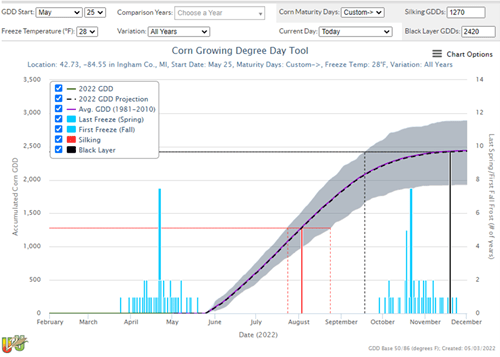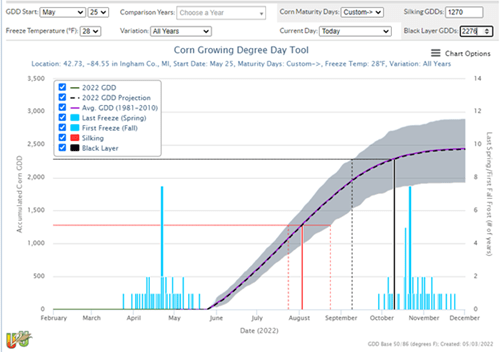Growing Degree Unit Compression
BY Dairyland Seed Agronomy Team
The extended cool and wet weather has kept many of us out of the fields and has raised concerns about planting delays, especially if replants are needed. A common question among growers is whether they should consider switching some of their full-season hybrids to shorter-maturity hybrids, and if so, how soon? The short answer to that question is no, it’s still a little early to consider switching hybrids. Although delayed planting shortens the growing season, the main driver is still growing degree units (GDUs) for the plant to reach physiological maturity before a killing frost.
GDUs, also called growing degree days (GDD) and heat units (HU), are the calculated accumulation of heat on a daily basis. The corn plant is very dependent on temperature to move through its growth stages. The warmer the temperature (to a max of 86°F) the faster a corn plant develops. An interesting observation over the past several years is that late planted corn hybrids are requiring less GDUs to reach maturity. Research conducted by Dr. Nielsen at Purdue and Dr. Thominson at Ohio State showed that corn can undergo compression during the reproductive stages to help reach physiological maturity (black layer). This means that a later planted corn plant is able to “make up ground” and reach black layer with significantly less GDUs.
GDU Compression
Dr. Nielsen at Purdue found that hybrids planted after May 1st and through the second week in June matured with 6.8 GDUs less per day. If a hybrid that required 2500 GDUs to reach maturity was planted on May 31st it would only require about 2300 GDUs to reach black layer. Research out of Michigan State indicates an average of 5.6 GDUs less per day after May 1st. The range of compression at Michigan State was 4.0 GDUs with 89 RM hybrids up to 7.4 GDUs with 109 RM hybrids, showing more compression with full-season hybrids. This gives us a benefit against switching maturities.
Useful to Usable Tool
The Useful to Usable (U2U) tool is a multi-state tool that uses current and historical climate data to help predict when your corn will reach certain growth stages including physiological maturity. This tool can be found at https://mygeohub.org/groups/u2u/purdue_gdd. Start by entering your location then enter the planting date of interest. Next you can manually enter the GDUs to silking and to maturity which can be found on the product tech sheets. Figure 1 shows an example of DS-4510Q planted on May 25th in Lansing, MI. The gray shaded region shows the highest and lowest expected GDU accumulation for the rest of the season. Anticipated silking date is represented by the red vertical line and the black vertical line represents the expected black layer date. The dashed black line indicates the first likely black layer date. The tall dark blue bar represents the probability of the first 28-degree night.

Figure 1. U2U example using DS-4510Q.
In the Figure 1 example, DS-4510Q is not predicted to reach black layer before the first 28-degree frost. One problem with this model is it does not take GDU Compression into consideration. If we figure 6 less GDUs for each day after May 1st (6 GDUs x 24 days = 144 GDUs less) then we would reduce the GDUs required to reach black layer by 144 units, making our black layer GDD number 2276. Figure 2 shows the same scenario with GDU compression and DS-4510Q is expected to reach black layer about 12 days before a killing freeze. Even if we delay the planting date to May 31st and account for the GDU compression, DS-4510Q is still expected to reach black layer a week before the most likely lethal freeze.

Figure 2. U2U example using DS-4510Q considering GDU Compression.
Remember this is just a projection of the most likely scenario but still gives you a very useful guide for your area. Although planting is delayed a little from previous years, we still have a lot of time to get seed in the ground. Another key point to keep in mind is planting into marginal soil conditions can reduce yield more than late planting. If you have any questions feel free to reach out to your local Dairyland Seed DSM or agronomist.

Brian Weller
Western Region
507.456.3034

Rod Moran
Western Region
507.456.3034

Dan Ritter
Central Region
219.863.0583

Branden Furseth
Northern Region
608.513.4265

Mark Gibson
Eastern Region
260.330.8968

Amanda Goffnett
Eastern Region
989.400.3793

Ryan Mueller
Eastern Region
989.400.3793
